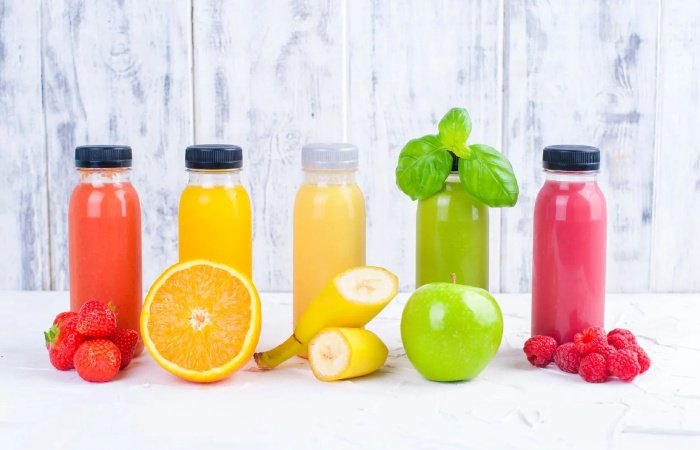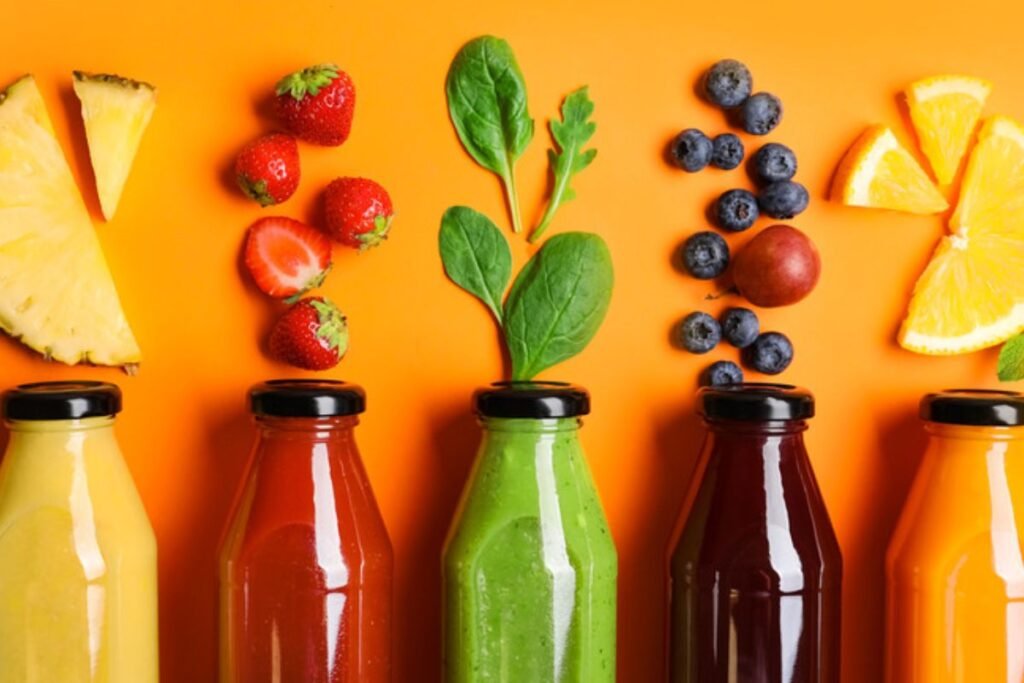Pressed juices has taken the health and wellness world by storm, gaining popularity for its refreshing taste and purported health benefits. This article delves into the details of pressed juice, exploring what it is, how it differs from squeezed juice, its nutritional value, health benefits, how to make it, and much more.
What are Pressed Juices?
Pressed juices, we call it as as cold-pressed juice, is made by extracting juice from fruits and vegetables using a hydraulic press.
This method involves applying thousands of pounds of pressure to the produce, ensuring that the maximum amount of liquid is extracted while preserving essential nutrients and enzymes.
Unlike other juicing methods that generate heat and oxidation, pressed juice maintains the integrity of its ingredients, offering a fresh and nutrient-rich beverage.
Retains More Nutrients: Cold-pressed juices retain more vitamins, minerals, enzymes, and antioxidants than regular juices because they are not exposed to heat or oxygen during the extraction process.
More fruit per serving: Cold pressing produces more fruit per serving because it doesn’t use heat.
Easy to digest: Cold-pressed juices generally do not contain pulp, which is rich in insoluble fiber.
Pressed Juices vs. Squeezed Juices
The primary difference between pressed and squeezed juice lies in the extraction method:
| Feature | Pressed Juices | Squeezed Juices |
|---|---|---|
| Extraction Method | Hydraulic press | Centrifugal force or manual squeezing |
| Heat Generation | No heat generated | Heat generated during extraction |
| Nutrient Retention | High, due to minimal oxidation | Lower, due to heat and oxidation |
| Fiber Content | Low (fiber removed) | Low (fiber removed) |
| Shelf Life | Short (24-48 hours) | Moderate (few days) |
| Taste | Fresh, pure taste of ingredients | Fresh but can be slightly oxidized |
| Cost | Higher due to specialized equipment | Lower due to simpler equipment |
| Ease of Preparation | Requires specialized juicer | Can be done with a simple juicer |
| Common Ingredients | Variety of fruits and vegetables | Typically fruits, some vegetables |
| Nutritional Value | High in vitamins, minerals, enzymes | Lower due to potential nutrient loss |
| Sugar Content | Depends on ingredients | Depends on ingredients |
| Popular Brands | Suja, Pressed Juicery, Blueprint | Tropicana, Simply Orange, Naked Juice |
Nutritional Value

The nutritional value of pressed juice can vary depending on the ingredients used. Here is a general nutritional breakdown for an 8-ounce (240 ml) serving of a mixed vegetable and fruit pressed juice:
| Nutrient | Amount Per Serving |
|---|---|
| Calories | 100 |
| Carbohydrates | 24g |
| Sugars | 18g |
| Fiber | 2g |
| Protein | 2g |
| Vitamin A | 25% DV |
| Vitamin C | 50% DV |
| Calcium | 4% DV |
| Iron | 4% DV |
| Potassium | 10% DV |
Pressed Juices Health Benefits
Pressed juice offers a variety of health benefits, including:
- Nutrient-Rich: Packed with vitamins, minerals, and antioxidants that support overall health.
- Improved Digestion: Enzymes in pressed juice can aid in breaking down food and improving gut health.
- Hydration: High water content in fruits and vegetables helps keep the body hydrated.
- Detoxification: Helps flush out toxins from the body due to its high nutrient and antioxidant content.
- Boosted Immunity: Vitamins like C and A support immune function and help ward off illnesses.
How to Make Pressed Juices?
Making pressed juice at home requires a cold-press juicer. Here’s a basic guide:
- Choose Your Ingredients: Select fresh, organic fruits and vegetables.
- Wash and Prep: Thoroughly wash your produce and cut it into pieces small enough to fit into your juicer.
- Juice: Feed the produce into the cold-press juicer. The machine will extract the juice using hydraulic pressure.
- Store: Pour the juice into an airtight container and refrigerate. Freshly pressed juice is best consumed within 24-48 hours.
Variations and Add-Ons
Pressed juices can be customized with a variety of ingredients to enhance flavor and nutrition:
- Greens: Spinach, kale, and parsley for added vitamins and minerals.
- Roots: Ginger and turmeric for anti-inflammatory properties.
- Fruits: Apples, berries, and citrus for natural sweetness and extra antioxidants.
- Herbs and Spices: Mint, basil, and cinnamon for unique flavors and additional health benefits.
- Superfoods: Chia seeds, spirulina, and wheatgrass for a nutritional boost.
Is Pressed Juice Healthier?
Pressed juice is often considered healthier than traditionally squeezed juice because it retains more nutrients due to the lack of heat and oxidation during the extraction process.
However, it is essential to note that pressed juice can also be high in natural sugars and lacks fiber, which is important for digestion and satiety.
Although most juices provide some nutritional value (e.g., vitamin C, potassium), they do not provide enough to warrant daily consumption. Indeed, juice is high in sugar and calories and lacks fiber. A better option to enjoy the health benefits of fruits is to eat fresh fruits in their whole form.
What is the Healthiest Pressed Juice?
The healthiest pressed juice is typically one that includes a balance of vegetables and fruits, with a focus on green leafy vegetables.
A combination like kale, spinach, cucumber, celery, green apple, and lemon provides a nutrient-dense beverage with a lower sugar content compared to fruit-only juices.
Best Times to Drink
- Morning: Kickstart your day with a nutrient boost and hydration.
- Pre-Workout: Provides a natural energy source without the crash.
- Post-Workout: Replenishes lost electrolytes and aids in recovery.
- Midday: A healthy alternative to sugary snacks or sodas.
Pairing with Meals
Pressed juices can complement meals by providing additional nutrients and flavors:
- Breakfast: Pair with oatmeal, yogurt, or a light smoothie bowl.
- Lunch: Enjoy alongside a salad, sandwich, or a protein bowl.
- Dinner: Use as a refreshing beverage with light, plant-based meals.
Pressed Juices Top Brands
Several brands have made a name for themselves in the pressed juice market:
- Suja: Known for organic, non-GMO, and cold-pressed juices.
- Pressed Juicery: Offers a wide range of flavors and cleanses.
- Blueprint: Focuses on raw, organic ingredients and balanced blends.
- Juice Press: Known for using high-quality, fresh ingredients.
- Evolution Fresh: Provides a variety of nutrient-dense juice options.
Conclusion
Pressed juice is a nutrient-rich beverage that offers a convenient way to consume a variety of fruits and vegetables. With its superior extraction method, it retains more vitamins, minerals, and enzymes compared to traditional juicing methods. Whether you make it at home or buy from reputable brands, incorporating pressed juice into your diet can provide numerous health benefits. Remember to balance your intake with whole foods to ensure you get enough fiber and avoid excessive sugar consumption. Enjoy pressed juice as part of a healthy, balanced diet to reap the maximum benefits.
Read More : Bamboo Juice: Benefits, Recipe, Nutrition Fact, Cold-Pressed Juice
FAQ’s
Cold-pressed juice lacks fiber since the juicing process removes the pulp, which can lead to rapid sugar absorption and spikes in blood sugar levels. Additionally, it has a short shelf life and must consume quickly to retain its nutritional benefits.
The healthiest pressed juice typically includes a mix of green vegetables like kale, spinach, cucumber, and celery, complemented with a small amount of fruit like green apple for sweetness, offering a nutrient-dense and low-sugar option.
Pressed juices can contain high levels of natural sugars, especially those made predominantly from fruits. It’s essential to balance fruit with vegetables to reduce sugar content and avoid spikes in blood sugar levels.
Cold-pressed juice is costly due to the high-quality, fresh produce required and the labor-intensive, slow hydraulic pressing process that extracts juice without heat, preserving nutrients and enzymes. Additionally, the short shelf life and need for specialized equipment add to production costs.

